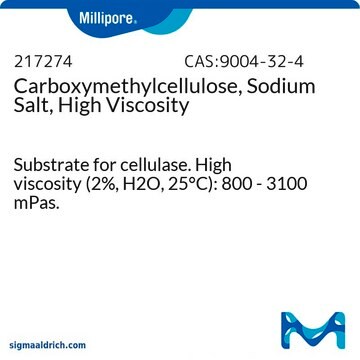Products may be shipped at a different temperature than the recommended long-term storage temperature. If the product quality is sensitive to short-term exposure to conditions other than the recommended long-term storage, it will be shipped on wet or dry-ice. If the product quality is NOT affected by short-term exposure to conditions other than the recommended long-term storage, it will be shipped at ambient temperature. As shipping routes are configured for minimum transit times, shipping at ambient temperature helps control shipping costs for our customers. For more information, please refer to the Storage and Transport Conditions document: https://www.sigmaaldrich.com/deepweb/assets/sigmaaldrich/marketing/global/documents/316/622/storage-transport-conditions-mk.pdf
419338
Sodium carboxymethyl cellulose
viscosity 2500-6000 cP
Synonym(s):
Carboxymethylcellulose sodium salt
Select a Size
Select a Size
About This Item
Recommended Products
form
powder
Quality Level
autoignition temp.
698 °F
extent of labeling
0.9 carboxymethyl groups per anhydroglucose unit
viscosity
2500-6000 cP
mp
270 °C (dec.)
SMILES string
[Na].OC(C(O)C(O)C=O)C(O)CO.OC(=O)C
InChI
1S/C6H12O6.C2H4O2.Na/c7-1-3(9)5(11)6(12)4(10)2-8;1-2(3)4;/h1,3-6,8-12H,2H2;1H3,(H,3,4);
InChI key
DPXJVFZANSGRMM-UHFFFAOYSA-N
Looking for similar products? Visit Product Comparison Guide
Related Categories
General description
Application
Storage Class Code
11 - Combustible Solids
WGK
WGK 1
Flash Point(F)
Not applicable
Flash Point(C)
Not applicable
Personal Protective Equipment
Choose from one of the most recent versions:
Already Own This Product?
Find documentation for the products that you have recently purchased in the Document Library.
Customers Also Viewed
-
How is shipping temperature determined? And how is it related to the product storage temperature?
1 answer-
Helpful?
-
-
How can I determine the shelf life / expiration / retest date of this product?
1 answer-
If this product has an expiration or retest date, it will be shown on the Certificate of Analysis (COA, CofA). If there is no retest or expiration date listed on the product's COA, we do not have suitable stability data to determine a shelf life. For these products, the only date on the COA will be the release date; a retest, expiration, or use-by-date will not be displayed.
For all products, we recommend handling per defined conditions as printed in our product literature and website product descriptions. We recommend that products should be routinely inspected by customers to ensure they perform as expected.
For products without retest or expiration dates, our standard warranty of 1 year from the date of shipment is applicable.
For more information, please refer to the Product Dating Information document: https://www.sigmaaldrich.com/deepweb/assets/sigmaaldrich/marketing/global/documents/449/386/product-dating-information-mk.pdfHelpful?
-
-
Is this compound suitable for In vivo work?
1 answer-
This product has not been tested for in vivo or in vitro use. However, based on a review of the peer-reviewed papers, this material has been used in animal models. Please see the link below to review this publication: https://onlinelibrary.wiley.com/doi/10.1002/adhm.201400250
Helpful?
-
-
I am trying to buy CMC that is the same as the one used in batteries, but I am not sure how the Molecular weight would affect its properties. would it matter if it was high or low?
1 answer-
Carboxymethyl Cellulose Sodium serves as a binder for electrode materials in batteries. The molecular weight is irrelevant as long as all the components (active material, binder, conductive agent) can be immobilized on the current collector without obvious agglomeration or exfoliation. One reference suggested that lower molecular weight CMC produced 'lower charge transfer resistance, higher ion conductivity, better wettability with the electrolyte, and better Li+ mobility as LIB binder.' Should a lower molecular weight material be of interest, see CMC product 419274, average Mw ~90,000. See the links below to review this product page as well as the reference cited above.
419273, Sodium Carboxymethyl cellulose
https://www.sigmaaldrich.com/product/aldrich/419273Assembly and electrochemical testing of renewable carbon-based anodes in SIBs: A practical guide
https://www.sciencedirect.com/science/article/pii/S209549562200479XSodium carboxymethyl cellulose as a potential binder for hard-carbon negative electrodes in sodium-ion batteries
https://www.sciencedirect.com/science/article/pii/S1388248114001209Helpful?
-
Active Filters
Our team of scientists has experience in all areas of research including Life Science, Material Science, Chemical Synthesis, Chromatography, Analytical and many others.
Contact Technical Service
![Poly[(o-cresyl glycidyl ether)-co-formaldehyde] average Mn ~870](/deepweb/assets/sigmaaldrich/product/structures/492/686/3e332037-f67b-49a2-8326-268fc7b0b900/640/3e332037-f67b-49a2-8326-268fc7b0b900.png)


